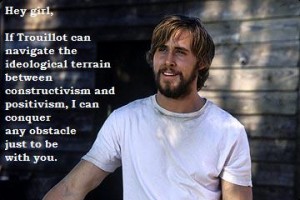Reflecting on Texts: Steven Lubar on Trouillot's "Silencing the Past"
04 September 2012 – Steve Lubar
Reflecting on texts, social justice, memory, scholarship, education, human rights, international, training, politics
NOTE: This post is part of a new and, we hope, semi-regular series in which public history educators share insights and observations about their use of “classic” texts in the public history classroom.
—
Michel Rolph Trouillot, historian, anthropologist, Haitian intellectual and University of Chicago professor, died in July at age 63. I first learned of his death on Twitter, from the tweets by several of my students. They had read his Silencing the Past: Power and the Production of History (Boston: Beacon Press, 1995) in my class, and it had stuck with them.
Silencing the Past is the only book that has been on my syllabus every time I have taught an introduction to public history or public humanities. It has lasted more than a decade. Most books last only a few years, but Silencing the Past remains, almost always the favorite book in evaluations and the one that students are most likely to refer to in other classes. Trouillot’s terms of historical analysis become a code for understanding history, a shorthand for discussing other books. Subsequent classes are filled with short references to positivism, constructivism, historicity 1 and historicity 2, unthinkable history, and especially, the varieties of silence in the historical record.
This is, on its face, unlikely. Silencing the Past is mostly about Haitian history. Trouillot is an anthropologist, not a historian. There is much in the book that seems to be there for the sake of argument, for discussion, rather than for making a traditional historical argument. The text is at times personal, at times theoretical, at times deep in the weeds of the archives. It jumps from one topic to another without much rhyme or reason. There’s not much mention of public history, as done by public historians, and certainly nothing practical here for students of public history.
Despite this, Silencing the Past serves as an excellent introduction to historical thinking and historical work for public historians. In part, that’s because of the topic: it’s rare that anyone in class has a stake in Haitian history. Everyone is on equal footing, bringing to the discussion only what’s in the book. But much more, I think, it is the style: Trouillot perfected a way of moving between the facts of a matter, and creation and understanding and presentation of those facts, looking at them from all sides. He was meta when meta wasn’t cool.
Silencing the Past has five chapters. We spend most of the class discussing the first two chapters, Trouillot’s analysis of power and silence in history, in Chapter One, and then the application of the silences of sources, archives, narratives, and history to the Haitian revolution, in the second chapter. Chapter Three steps back to see how the Haitian revolution was considered “impossible,” and how that shaped the way it was received and the way its history has been written. There’s always a good discussion of what other histories might be impossible.
Chapter Four widens the focus to the history of the celebration of Columbus Day, and leads to a good discussion of the nature of commemoration. Chapter Five, very short, considers the place of authenticity in history-writing by focusing on presenting the history of slavery at the proposed Disney’s America theme park. Students wrestle with a question they are deeply concerned about, the challenges of telling someone else’s history
Trouillot’s goal in Silencing the Past is to find “the many ways in which the production of historical narratives involves the uneven contribution of competing groups and individuals who have unequal access to the means for such production” (p. xix). He argues that by analyzing that power, by making it visible, we can understand how it works in the world. I think that is part of the appeal of the book. It suggests that by looking closely at the work of history, we can understand its power, know its secrets, unveil it, and perhaps put it to use for good. Public history students find that a very appealing notion.
~ Steven Lubar, Professor, Departments of American Studies and History and Director, John Nicholas Brown Center for Public Humanities and Cultural Heritage Brown University
Image source: Public History Ryan Gosling, Nov. 22, 2011





By coincidence, my graduate students are discussing this text tonight! It’s been a favorite of mine since my own graduate student seminar. Trouillot offers that rare and wonderful combination of intellectual depth and readability. I gave it to a bookish friend (not a historian) and told him it was one of the best books about history I’d read. His review was “This was one of the best books I’ve read, period.” Well-done review here!
Unfortunately, I didn’t come across Trouillot’s work until this summer, when one of the many essays commemorating his work convinced me I should read Silencing the Past. It’s a wonderful collection, and I’m glad to see other public historians have included it in their courses. Trouillot will certainly be on my syllabus if I ever get to teach an intro to public history.
[The essay that won me over is from the blog “Thinking Anthropologically.” This is the link: http://www.livinganthropologically.com/2012/07/08/should-be-reading-anthropology-changed-everything/%5D